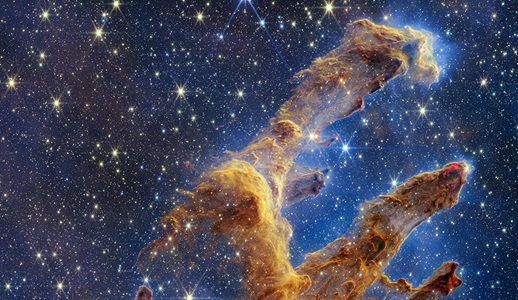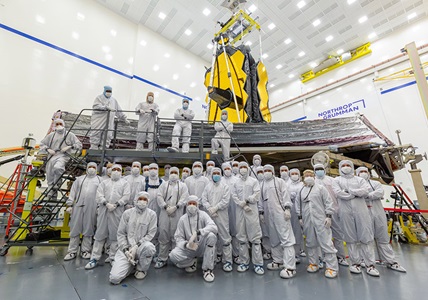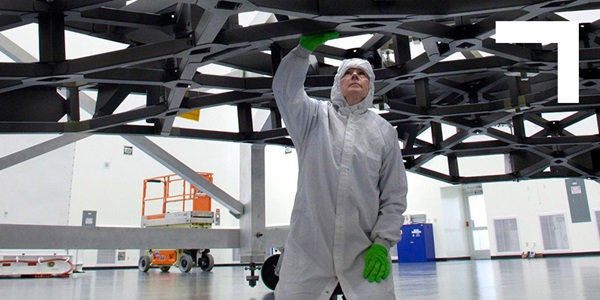The James Webb Space Telescope is Changing Our Understanding of the Universe —3 Top Observations
The Great Observatories
Building Space Telescopes Past, Present and Future

By Omar Torres
When it comes to solving the mysteries of the universe, Northrop Grumman has pioneered groundbreaking technologies from the very beginning of the Space Age. Our engineering and innovation have made possible a decades-long list of historic space missions to help humanity peer farther into the cosmos than ever before, including most recently with the James Webb Space Telescope (Webb).
From 1990 to 2003, NASA embarked on four flagship astronomical missions known as the “Great Observatories.” Supported by our team at Northrop Grumman, each contributed significantly to astrophysics and inspired a new generation of engineers and scientists. Future astrophysics missions — like NASA’s Habitable Worlds Observatory (HWO), which will search for signs of life on other planets —present a leap forward in our pursuit to advance humanity’s understanding of deep space.
Discovering Humanity’s First Great Observatories
Exploring our next frontier in space requires first considering the trailblazing contributions Northrop Grumman has made to past and present space observatories.
[1990] Hubble Space Telescope: We designed and fabricated the optical benches and thermal controls, provided engineering support and designed the tools used by the astronauts to service the telescope in space. This allowed Hubble to continue its mission and capture some of the most remarkable images of the universe to date. Hubble orbits 326 miles above Earth’s surface and has made more than 1.5 million observations over the course of its lifetime.
[1991] Compton Gamma Ray Observatory: Built by our team to observe the high-energy universe, Compton’s four science instruments covered six orders of magnitude in energy. This allowed the observatory to advance the study of gamma ray bursts, map the Milky Way and share insights into the distribution of high-energy radiation.
[1999] Chandra X-Ray Observatory: We built Chandra — the world’s most powerful X-ray telescope — to study dark matter, black holes and supernova remnants. Today, our engineers provide key operational support and maintenance. Chandra even teamed up with Webb in 2022 to scan the universe in new ways and will mark 25 years in service this summer.
[2003] Spitzer Space Telescope: Peering into the corners of space that are invisible to optical telescopes, Spitzer was the first infrared observatory to detect light from an exoplanet. It also developed the first weather map highlighting temperature differentiations of an alien planet. Our engineers developed technical concepts that supported the infrared array camera.
Exploring the Universe
When it comes to state-of-the-art technologies, Webb is the undisputed infrared powerhouse. Built by Northrop Grumman and launched in 2021, Webb is the first space deployable observatory. In other words, it traveled to space folded, origami style, inside a rocket and then unfolded — i.e., deployed — its sunshield and mirrors on its voyage a million miles away to Lagrange Point 2.
“Webb is only in its sophomore year of science operations and with every new discovery it makes, we’re proving that our design and meticulous engineering will serve as a gateway for HWO [Habitable Worlds Observatory],” said Charlie Atkinson, chief engineer of the Webb program at Northrop Grumman.
Today, a dedicated team at Northrop Grumman provides maintenance support to Webb using testbeds that simulate the observatory on the ground and developing flight software to ensure Webb continues to operate optimally.
Searching for Habitable Worlds
As humanity's curiosity about exoplanets intensifies, Northrop Grumman engineers and scientists have focused on new architectures and design models to help pave the way for NASA’s next ambitious science mission: HWO. This future space-based telescope will search for habitable planets. The question “Are we alone?” and whether we can sustain life on other planets is not just something out of the movies; here at Northrop Grumman, it’s simply a matter of building upon decades of mission expertise to solve an engineering challenge.
“We’re taking proven technologies to the next level and applying a holistic view on everything from architecture trades, in-space servicing, assembly and manufacturing to lessons learned on Webb and Chandra,” said Tiffany Glassman, chief engineer for civil space programs at Northrop Grumman. “We're turning science-fiction into reality, and that is beyond exciting.”
Learn more about how Northrop Grumman is defining possible in the cosmos, or explore what life is like at Northrop Grumman.


